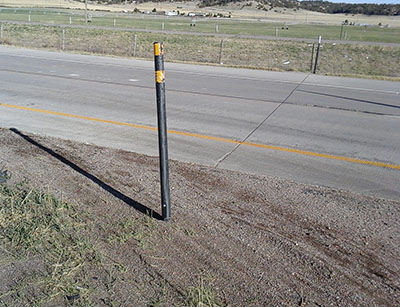- Home
- Administration
- Aeronautics
- Business with WYDOT
- Construction Projects
- Driver License and Records
- Economic Stimulus Projects (ARRA - TIGER)
- Engineering and Technical Programs
- Fuel Tax
- Highway Safety
- Human Resources
- Manuals and Publications
- News and Information
- Permits
- Planning/Projects/Research
- Titles, Plates and Registration
- Travel
- Trucking / Commercial Vehicles
- Vehicle Business Regulation
- Wyoming Highway Patrol
- Search
- Sitemap
WYDOT installs flexible delineators for safer roads
January 19, 2017
 The Wyoming Department of Transportation is making sure its roads are even safer for the traveling public by ensuring road markers remain intact and visible.
The Wyoming Department of Transportation is making sure its roads are even safer for the traveling public by ensuring road markers remain intact and visible.
In certain areas where vehicles have repeatedly damaged delineator posts, WYDOT installed flexible delineator posts made by Shur-Tite that can withstand being hit or run over numerous times without breaking.
Delineators help motorists see where the side of the road is during adverse weather conditions. WYDOT’s maintenance crews also use the posts as a way to see the road when they plow. Maintenance crews and emergency personnel also use the delineators to determine where emergency crossovers are on the interstates so they can get from one direction to the next without having to go to an exit.
“Initially, I was a little skeptical about how they were going to hold up, but they have done amazingly well,” said Tim McGary, District 1 maintenance engineer. “You can run over them numerous times, and they don’t break. It seems like even in the cold they don’t break, and they pop right back up.”
The metal posts tend to bend immediately after being hit. That can create a hazard because a bent post can possibly injure someone or damage a vehicle.
District 1 is adding more of the flexible delineators at the crossovers to combat frequent repairs. Maintenance crews can accidentally run into the delineators when clearing snow, and motorists can also mistakenly run them over with their vehicles if they use the crossover while towing a trailer.
At the crossovers, the diameter of the posts is larger so maintenance crews and emergency personnel can see them easier. Instead of the typical 2 ½ inch diameter posts, the crossovers have 3 ½ inch diameter posts with reflective material that can be seen in all directions.
“So now, not only do we have the flexibility at the crossovers, but if you’re an ambulance, or a wrecker or a law enforcement officer and have to go backward, you can tell where the crossovers are because you can see the reflectivity from any direction,” McGary said.
McGary said one of his maintenance foremen installed the flexible delineators several years ago and has only had to replace a handful of them since.
Although the flexible delineators may cost more initially, McGary said they’re actually cost effective because maintenance crews don’t have to constantly replace them.
“We don’t have to replace very many of the flexible delineators, but when we do the base is already in the ground,” McGary said. “All you do is pull a pin and put a new one in its place, and it’s done.”
With the traditional delineator posts, crews can try to straighten them. But the material makes it difficult to fix, and the posts can snap.
“Probably the best thing to do when they’re bent over is literally just cut them off, drive the remaining stub into the ground and stick another one right next to it,” McGary said.
However, those stubs can be harmful to maintenance equipment because they can end up puncturing tires on motor graders and snow plows that are clearing the roads.
With the delineators being flexible, crews thought they wouldn’t be rigid enough to hold roadwork signs.
“When the signs are added to the flexible delineators, if it’s windy, they get folded over,” McGary said. “So initially we thought we would have to put roadwork signs on sign stands.”
Brand Fogg, a foreman in District 1, however, solved the problem. When conditions are too windy, he replaces some of the flexible signs with metal post construction signs he built. Crews can easily replace the signs by using the existing base of the flexible delineators.
“You just need to be a little inventive,” Fogg said of the signs he made.
When it’s not too windy, crews can still use the flexible delineators without them collapsing.
Besides using them as delineators, Fogg has tested the mile marker signs on the flexible posts, which can have the same maintenance benefits as the delineators.








